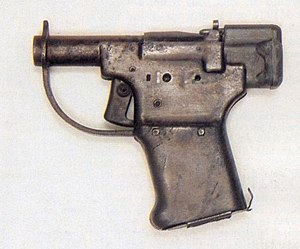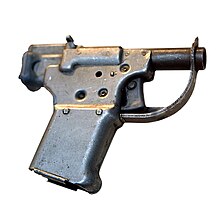FP-45 Liberator
| FP-45 Liberator | |
|---|---|
 The FP-45/M1942 | |
| Type | single-shot pistol |
| Place of origin | |
| Service history | |
| In service | 1942-1945 |
| Used by | China, Philippines, France, Poland, Yugoslavia |
| Wars | World War II |
| Production history | |
| Manufacturer | Guide Lamp Corporation of GMC |
| Produced | June 1942-August 1942 |
| No. built | 1,000,000 |
| Specifications | |
| Mass | 1 lb. (454 g) |
| Length | 5.55 in. (141 mm) |
| Barrel length | 4 in. (102 mm) |
| Cartridge | .45 ACP |
| Action | single-shot |
| Muzzle velocity | 820 ft/s (250 m/s) |
| Feed system | single shot |

The FP-45 Liberator was a pistol manufactured for the United States military during World War II for use by resistance forces in occupied territories.
History
The pistol had its origins in the US Army Joint Psychological Committee and was designed for the United States Army in 1942 by the Inland Guide Lamp Manufacturing Division of the General Motors Corporation in Dayton, Ohio.[1] Interestingly, the army designated the weapon the Flare Projector Caliber .45 hence the designation FP-45. This was done to disguise the fact that a pistol was being mass produced. The original engineering drawings label the barrel as "tube", the trigger as "yoke", the firing pin as "control rod", and the trigger guard as "spanner". The Guide Lamp Division plant in Anderson, Indiana assembled a million of these weapons. The Liberator project took about 6 months from conception to end of production with about 11 weeks of actual manufacturing time, done by 300 workers.
Design
The weapon was a crude, single shot pistol designed to be cheaply and quickly mass produced. The Liberator had just 23 parts. The weapon largely used stamped and turned steel parts that were cheap and easy to manufacture. The weapon fired a .45 caliber pistol cartridge from an unrifled barrel. Due to the unrifled barrel, maximum effective range was only about 25 feet (less than 8 m). In reality, the actual effective range was closer to about 10 feet (3 m). After that, the oblong .45 ACP bullet (designed for a rifled barrel) would begin to tumble out of control and impact sideways ("keyholing").
Use
The Liberator was shipped in a cardboard box with 10 rounds of .45 ACP ammunition, a wooden dowel to remove the empty shell casing, and an instruction sheet in comic strip form[1] showing how to load and fire the weapon. Excess rounds of ammunition could be stored in the pistol grip.
After production, the Army turned the Liberators over to the OSS. A crude and clumsy weapon, the Liberator was never intended for front line service. It was originally intended as an insurgency weapon to be mass dropped behind enemy lines to resistance fighters in occupied territory. The resistance fighters were to recover the weapons, sneak up on an Axis occupier, either kill him or knock him out and retrieve his weapon(s). Many resistance fighters called the FP-45 "a great weapon to get another one with".
The weapon was valued as much for its psychological warfare effect as its actual field performance. It was believed that if vast quantities of these weapons could be delivered into Axis occupied territory, it would have a devastating effect on the morale of occupying troops. The plan was to drop the weapon in such great quantities that occupying forces could never capture or recover all the weapons. It was hoped that the thought of thousands of these unrecovered weapons potentially in the hands of the citizens of occupied countries would have a deleterious effect on enemy morale.
In reality, the OSS never saw the practicality in mass dropping the Liberator over occupied Europe, and only a handful were ever distributed. Only the Chinese and resistance forces in the Philippines received the Liberator in any significant quantity. The Liberator was never issued to American or Allied troops and there is no known instance of the weapon ever actually being used in combat.
The original delivered cost for the FP-45 was $2.40/unit[1] ($26 in 2005). A Liberator in good condition today can fetch approximately $2500, with the original box bringing an additional $1500, with an original extremely rare paper instruction sheet the value could exceed $4500 to a collector of rare World War II militaria. There are fakes of these sheets, but the real ones had a watermark that can be seen clearly, which is difficult to duplicate.
An interesting fact about the Liberator is that the factories could produce one faster than the weapon could be loaded and fired. The factory turned out a pistol every six or seven seconds whilst loading took about 10 seconds.
Another variant of this gun was a two shot version which never made general production. It had two chambers, where one would be fired and then the other slid into position to fire. This version is extremely rare.
The concept revived
The Liberator was replaced with the Deer gun in 1964 when a modernised equivalent was designed for possible use in Vietnam [1]. This was due to the fact that the CIA needed a weapon of this type, and most Liberators had been scrapped after WWII. The Deer Gun, or sometimes Dear Gun, was chambered for 9 mm Luger Parabellum, and was loaded by unscrewing the barrel and inserting a round to fire. Almost all of these were scrapped, making the Deer gun rarer than a Liberator.
References
External links
- The Liberator Pistol (with pictures)
- Liberator Pistol FP-45 - A page on the Canadian National Firearms Association website.
- Additional photos of the Liberator pistol
- The Liberator instruction sheet
